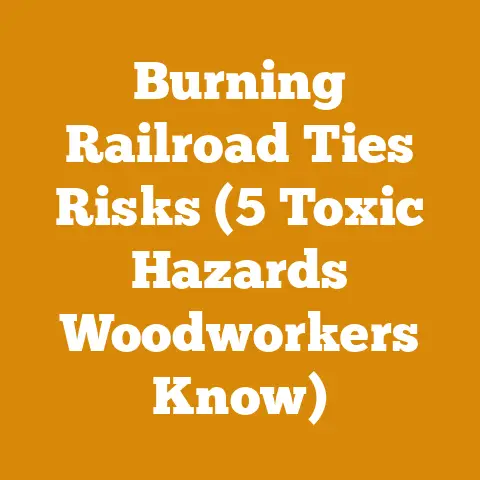Peavey Hook vs Cant Hook: Essential Firewood Tools Compared (Pro Insights)
“Peavey Hook vs Cant Hook: Essential Firewood Tools Compared (Pro Insights)”
Introduction: A Timberjack’s Tale and the Legacy of Leverage
The story of the peavey and cant hook is intertwined with the very history of logging. Picture this: it’s the mid-19th century, the vast forests of Maine and the Pacific Northwest are echoing with the sounds of axes and the shouts of lumberjacks. Logs, some of them giants, need to be moved, rolled, and positioned with brute force. It was in this environment that Joseph Peavey, a blacksmith from Maine, developed a tool that would forever change the way timber was handled – the peavey hook. Before Peavey’s invention, the cant hook was already in use, but the addition of a spike at the end of the handle by Peavey provided greater leverage and control, especially on uneven terrain.
I’ve spent years in the woods, from the dense forests of the Pacific Northwest to the hardwood stands of the Northeast. I’ve seen firsthand how these tools – the peavey and the cant hook – can make or break a firewood operation, whether you’re a weekend warrior or a seasoned pro. I’ve wrestled with logs that seemed determined to stay put, and I’ve learned the hard way which tool is best for which job. In this guide, I’m going to share my insights, along with detailed technical specifications, to help you choose the right tool and use it safely and effectively.
Peavey Hook vs. Cant Hook: Understanding the Fundamentals
Before diving into the nitty-gritty, let’s establish a clear understanding of what each tool is and what it’s designed to do.
- The Peavey Hook: Characterized by its distinctive spike at the end of the handle, the peavey is designed for moving, turning, and positioning logs, especially in rough terrain. That spike allows you to get a solid grip, even on icy or muddy ground. It’s the tool I reach for when I need maximum leverage and control.
- The Cant Hook: Lacking the spike, the cant hook is primarily used for rolling logs on relatively even surfaces. The hook itself is designed to bite into the wood, providing the necessary grip for turning. It’s generally better suited for tasks where precision is less critical than speed.
When to Use a Peavey Hook
I find the peavey hook indispensable in a variety of situations. Its design lends itself to tasks where secure grip and enhanced leverage are paramount.
- Rough Terrain: When working on uneven or sloping ground, the spike on the peavey provides a crucial anchor point. I’ve used it countless times to maneuver logs up hillsides or across rocky areas, where a cant hook would simply slip.
- Large Diameter Logs: For handling larger logs, the added leverage of the peavey is a game-changer. The spike helps prevent the tool from slipping, allowing you to exert more force.
- Freeing Stuck Logs: If a log is wedged between others or stuck in the mud, the peavey’s spike can be used to pry it loose. I’ve spent hours extricating logs in this way, and I can tell you, without the peavey, it would have been backbreaking work.
- Precision Positioning: The peavey allows for more precise control when positioning logs for bucking or splitting. The spike lets you make small adjustments with ease.
When to Use a Cant Hook
While the peavey is my go-to tool in many situations, the cant hook has its own advantages, particularly when speed and efficiency are key.
- Even Surfaces: On relatively flat ground, the cant hook can be used to roll logs quickly and efficiently. Without the spike, it’s easier to move the tool along the log’s surface.
- Smaller Diameter Logs: For smaller logs, the cant hook provides sufficient leverage without the need for the spike. It’s a lighter and more maneuverable option.
- High-Volume Operations: In situations where you need to move a lot of logs quickly, the cant hook can be more efficient. The lack of a spike means you don’t have to worry about constantly repositioning the tool.
- Log Decks: When working on a log deck, the cant hook is ideal for rolling logs into position for processing.
Technical Specifications: A Deep Dive
To make an informed decision, it’s essential to understand the technical specifications of both peavey hooks and cant hooks. This includes measurements, materials, and load capacities.
Peavey Hook Specifications
- Handle Length: Typically ranges from 36 inches to 60 inches. I prefer a 48-inch handle for most tasks, as it provides a good balance of leverage and maneuverability. For larger logs (over 24 inches in diameter), a 60-inch handle is often necessary.
- Handle Material: Hickory is the most common material due to its strength and shock-absorbing properties. Some manufacturers also use ash or fiberglass. Fiberglass handles are more durable and weather-resistant but lack the traditional feel of wood.
- Technical Note: Hickory has a modulus of rupture (MOR) of approximately 17,000 psi, making it highly resistant to breaking under bending stress.
- Hook Material: High-carbon steel is essential for the hook to withstand the stresses of lifting and turning logs. Look for hooks that have been heat-treated for added strength and durability.
- Technical Note: High-carbon steel typically has a carbon content of 0.6% to 1.0%, which increases its hardness and tensile strength.
- Spike Material: Similar to the hook, the spike should be made of high-carbon steel and heat-treated. The spike should be securely attached to the handle, either by threading or welding.
- Technical Note: The Rockwell hardness of the spike should be at least 50 HRC to ensure it can penetrate tough bark and wood.
- Weight: Varies depending on the size and materials used. A typical 48-inch peavey weighs between 6 and 8 pounds.
Cant Hook Specifications
- Handle Length: Similar to peavey hooks, cant hook handles range from 36 inches to 60 inches. Again, I find a 48-inch handle to be a good all-around choice.
- Handle Material: Hickory, ash, and fiberglass are all common handle materials.
- Hook Material: High-carbon steel, heat-treated for strength and durability.
- Latch Mechanism: Some cant hooks feature a latch mechanism that locks the hook in place, providing added security when rolling logs. This is a feature I highly recommend, especially for larger logs.
- Weight: Slightly lighter than peavey hooks, typically weighing between 5 and 7 pounds for a 48-inch model.
Material Considerations: Wood Species and Moisture Content
The type of wood you’re working with can significantly impact the performance of your peavey or cant hook. Hardwoods, such as oak and maple, are denser and require more force to move than softwoods like pine and fir.
- Hardwoods: These woods have a higher density and interlocked grain, making them more difficult to split and turn. I’ve found that hardwoods require a sharper hook and a more aggressive technique.
- Technical Data: Oak, for example, has a density of approximately 0.75 g/cm³, while pine has a density of around 0.45 g/cm³.
- Softwoods: Softer woods are easier to handle but can also be more prone to splintering. The hook on your peavey or cant hook needs to be kept sharp to prevent this.
- Moisture Content: Wet wood is heavier and more difficult to move. Ideally, firewood should be seasoned to a moisture content of 20% or less before being burned.
- Technical Note: Freshly cut wood can have a moisture content of 50% or more. Seasoning reduces the moisture content, making the wood easier to burn and reducing smoke emissions. I use a moisture meter to test firewood before stacking it.
Safety First: Best Practices for Using Peavey Hooks and Cant Hooks
Safety is paramount when working with any logging tool. Here are some essential safety tips to keep in mind:
- Wear Appropriate PPE: Always wear safety glasses, gloves, and steel-toed boots when handling logs. A hard hat is also recommended, especially when working in areas with overhead hazards.
- Maintain a Safe Distance: Keep a safe distance from others when rolling logs. A rolling log can cause serious injury or even death.
- Use Proper Lifting Techniques: Lift with your legs, not your back. Avoid twisting or bending when lifting.
- Inspect Your Tools Regularly: Check your peavey or cant hook for signs of damage, such as cracks in the handle or a dull hook. Replace damaged tools immediately.
- Sharpen Your Hook: A sharp hook is essential for safe and efficient operation. Use a file or grinder to keep the hook sharp.
- Be Aware of Your Surroundings: Watch out for obstacles, such as rocks, stumps, and branches.
- Never Work Alone: It’s always safer to work with a partner, especially when handling large logs.
- Use Caution on Slopes: When working on slopes, be extra careful to avoid losing control of the log. Use chocks or wedges to prevent the log from rolling downhill.
- Proper Storage: Store your peavey and cant hook in a dry place to prevent rust and corrosion.
Tool Maintenance: Keeping Your Tools in Top Condition
Regular maintenance is essential for prolonging the life of your peavey and cant hook and ensuring they perform optimally.
- Sharpening: As I mentioned earlier, a sharp hook is crucial. Use a file or grinder to sharpen the hook regularly. I prefer to use a mill bastard file for sharpening, as it provides a good balance of speed and precision.
- Technical Tip: When sharpening, maintain the original angle of the hook. Avoid over-sharpening, as this can weaken the hook.
- Handle Care: Inspect the handle regularly for cracks or splinters. If the handle is damaged, replace it immediately. To protect the handle from the elements, apply a coat of linseed oil or varnish.
- Metal Protection: Keep the metal parts of your peavey or cant hook clean and dry to prevent rust. Apply a coat of oil or grease to protect them from corrosion.
- Tightening: Check the bolts and screws that hold the hook and spike in place. Tighten them as needed to prevent loosening.
- Storage: Store your tools in a dry place, preferably hanging on a wall or rack. This will prevent them from getting damaged or lost.
Case Study: My Experience with a Massive Maple Log
I once faced a particularly challenging situation involving a massive maple log that had fallen across a trail on my property. The log was approximately 30 inches in diameter and 16 feet long – a real behemoth. It was also lying on a slight incline, making it even more difficult to move.
I initially tried using a cant hook, but it simply didn’t provide enough leverage to budge the log. The hook kept slipping, and I was expending a lot of energy with little to show for it. Frustrated, I switched to my trusty peavey hook.
The spike on the peavey allowed me to get a solid grip on the log, even on the uneven terrain. I was able to use the leverage of the handle to slowly but surely roll the log off the trail. It took several hours of hard work, but without the peavey, I’m not sure I could have done it.
This experience reinforced my belief that the peavey hook is the superior tool for handling large, heavy logs, especially in challenging conditions.
Firewood Preparation: From Log to Fire
The peavey and cant hook are essential tools for preparing firewood. Here’s a step-by-step guide to the process:
- Felling the Tree: Before you can prepare firewood, you need to fell a tree. Always follow safe felling practices, including wearing appropriate PPE and assessing the surrounding area for hazards.
- Limbing: Once the tree is on the ground, remove the branches using a chainsaw or axe.
- Bucking: Cut the trunk into manageable lengths using a chainsaw. The length of the logs will depend on the size of your wood stove or fireplace. I typically cut logs to 16-inch lengths.
- Technical Note: When bucking, be sure to support the log to prevent it from pinching the saw. Use wedges or other logs to create a stable platform.
- Splitting: Split the logs into smaller pieces using a splitting axe or maul. For larger logs, a hydraulic log splitter may be necessary.
- Technical Note: Split logs along the grain to make the process easier. Avoid splitting knots, as they can be very difficult to split.
- Stacking: Stack the split firewood in a well-ventilated area to allow it to season.
- Technical Note: Stack firewood in a single row, with the bark facing up. This will help to shed water and prevent rot. Allow at least six months for the wood to season properly.
- Moving Logs: This is where the peavey and cant hook come in. Use these tools to move the logs from the felling site to the bucking area, and from the bucking area to the splitting area. They can also be used to stack the split firewood.
Sourcing Quality Tools: What to Look For
When purchasing a peavey or cant hook, it’s important to choose a high-quality tool that will last for years. Here are some things to look for:
- Reputable Brand: Stick with well-known brands that have a reputation for quality and durability.
- High-Quality Materials: Look for handles made of hickory or ash, and hooks made of high-carbon steel.
- Solid Construction: Inspect the tool for any signs of weakness or poor workmanship.
- Comfortable Grip: Choose a handle that feels comfortable in your hand.
- Warranty: A good warranty is a sign that the manufacturer stands behind their product.
Adapting to Global Challenges: Sourcing Materials and Tools
I recognize that sourcing quality materials and tools can be a challenge, depending on your location. Here are some tips for overcoming these challenges:
- Local Suppliers: Start by checking with local hardware stores and logging supply companies. They may be able to source high-quality tools and materials.
- Online Retailers: If you can’t find what you need locally, consider purchasing online. There are many reputable online retailers that specialize in logging tools.
- Used Tools: Consider purchasing used peavey hooks and cant hooks. You can often find them at flea markets, yard sales, or online auction sites. Just be sure to inspect them carefully for damage before buying.
- DIY Options: If you’re handy, you may be able to build your own peavey or cant hook. There are many plans and tutorials available online.
The Future of Logging Tools: Innovations and Trends
The world of logging tools is constantly evolving, with new innovations and trends emerging all the time. Here are a few things to keep an eye on:
- Ergonomic Designs: Manufacturers are increasingly focusing on ergonomic designs to reduce fatigue and improve safety.
- Lightweight Materials: New materials, such as carbon fiber, are being used to create lighter and more durable tools.
- Electric and Hydraulic Tools: Electric and hydraulic log splitters and other tools are becoming more popular, offering increased power and efficiency.
- Smart Technology: Some logging tools are now equipped with sensors and other smart technology to track performance and improve safety.
Conclusion: Choosing the Right Tool for the Job
Choosing between a peavey hook and a cant hook ultimately depends on the specific task at hand. The peavey hook, with its spike, excels in rough terrain and when handling large logs, providing maximum leverage and control. The cant hook, on the other hand, is better suited for even surfaces and smaller logs, offering speed and efficiency.
Having spent years working with wood, I can say that both tools have earned their place in my arsenal. Understanding their strengths and limitations, and prioritizing safety, will help you tackle any firewood preparation task with confidence. Whether you’re a seasoned logger or a weekend warrior, the right tool can make all the difference. Now, get out there and put these tools to work!
Appendix: Technical Data and Specifications
| Feature | Peavey Hook | Cant Hook |
|---|---|---|
| Handle Length | 36-60 inches | 36-60 inches |
| Handle Material | Hickory, Ash, Fiberglass | Hickory, Ash, Fiberglass |
| Hook Material | High-Carbon Steel, Heat-Treated | High-Carbon Steel, Heat-Treated |
| Spike | Yes | No |
| Latch Mechanism | No | Optional |
| Weight | 6-8 pounds (48-inch model) | 5-7 pounds (48-inch model) |
| Best Use | Rough Terrain, Large Logs, Precision Positioning | Even Surfaces, Smaller Logs, High-Volume Operations |
| Safety Standards | ANSI Z133.1 (General Safety) | ANSI Z133.1 (General Safety) |
| Wood Moisture Content for Firewood | <20% (Seasoned) | <20% (Seasoned) |
Disclaimer: The information provided in this guide is for general informational purposes only. Always follow safe working practices and consult with a qualified professional if you have any questions or concerns. I am not responsible for any injuries or damages that may result from the use of this information.






